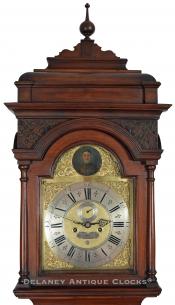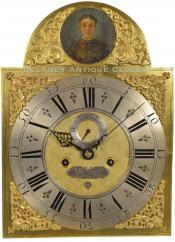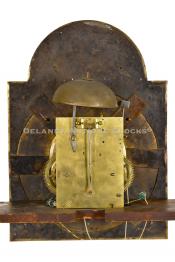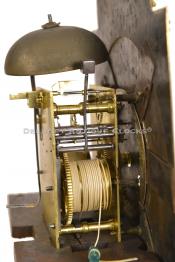George Crow of Wilmington, Delaware. This is an elegant and important pre-revolutionary brass dial American walnut cased tall clock. BBB-4.
This is an elegant and important pre-revolutionary brass dial American tall case clock made by George Crow of Wilmington, Delaware, circa 1745.
This very nicely proportioned black walnut case exhibits a historic finish and a natural chocolate coloring. The case stands on an applied bracket base. The design includes feet and shaped returns or spurs. The base panel features two book-matched selections of figured walnut positioned horizontally. The waist moldings are well-formed. The waist section is long and centers a tombstone-shaped waist door. This door is trimmed along its perimeter with a molded edge and is hinged. It opens to allow one access to the case's interior. This is where one will find the two brass-covered drive weights and the brass-faced pendulum bob. The rating of the mechanism is adjusted by manipulating the threaded nut positioned under the bob. The top rail of the waist, above the waist door, meets the stiles in mitered seams. This joinery creates a more pleasing aspect than the traditional 90-degree mortise-and-tenon joinery typically used in this location and is used in the section below the waist door. The bonnet features a sarcophagus top. This is constructed with multiple levels. A turned wooden finial is mounted on top of a central plinth. Solid frets help secure the plinth in place. The bonnet frieze is decorated with blind fretwork. The molded arch is visually supported by turned and shaped hood columns. The arch design recurs above the sidelights in the hood, creating a bold, arcade-like architectural statement. So dew tall case clocks are visually interesting from the sides. The front two columns are secured to the arched and glazed bonnet door. The back two are quarter columns fitted into the back corners of the hood.
This composite brass dial predates the painted dial form. It is constructed with a brass sheet and is decorated with several elements. Four cast corner spandrels frame the applied time ring. These spandrels are decorated with twin cherubs that support a crown. There are two additional spandrels located in the arch. These are referred to as the dolphin spandrels and were quite popular. They center a circular-shaped painting of a woman. The silvered time or chapter ring features Arabic-style five-minute markers, a closed minute ring, Roman-style hour numerals, and an interior minute ring. A decorative dot-and-triangle detail is located between each hour. Inside this ring, the dial surface has been textured or matted. Here one will also find a small round aperture for the calendar day display and a subsidiary engraved seconds dial. A large applied plaque is located below the center arbor. The plaque is engraved with the Maker's name. This engraved nameplate reads." George Crow / Wilmington." The winding arbors are ring-turned. The hour and minute hands are steel and are a traditional form for the period.
The two-train movement is brass, eight-day duration, and is of good quality. Four-ting-turned pillars or posts support the two large brass plates. Hardened steel shafts support the polished steel pinions and brass gearing. The winding drums are grooved. The escapement is designed in a recoil format. The movement is weight driven. The strike is controlled by a rack and snail striking system. As a result, it will strike each hour on the hour on a cast iron bell mounted above the movement.
This clock was made circa 1745 and stands approximately 98 inches or 8 feet 2 inches tall to the top of the pagoda, 20 inches wide and 10 inches deep, measured at the cornice molding.
This clock and case are closely related to an example currently in the Briggs Museum of American Art.
Inventory number BBB-4.
George Crow's birth dates have yet to be discovered. It is assumed he trained in Philadelphia and moved to Wilmington. A clock is known that is signed 1744. Public records established him in Wilmington in 1746. It is recorded there that he served as Wilmington's High Constable and was married in the same year. George had four children. Two, Goerge Jr and Thomas Crow, also worked in the clock trades. Thomas appears to have been involved in clockmaking as early as 1770. He becomes one of Delaware's most prolific and best-known clockmakers. George died in 1762. His estate inventory included unfinished clocks and cases.
A fine example of his work is in the Briggs Museum of Art collections.
















